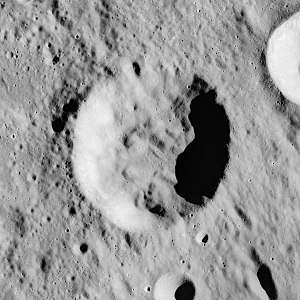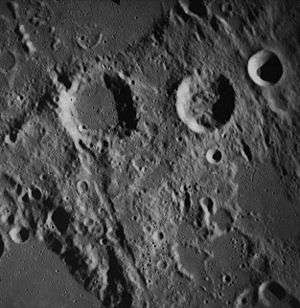Hind (crater)
 Apollo 16 image | |
| Coordinates | 7°54′S 7°24′E / 7.9°S 7.4°ECoordinates: 7°54′S 7°24′E / 7.9°S 7.4°E |
|---|---|
| Diameter | 29 km |
| Depth | 3.0 km |
| Colongitude | 353° at sunrise |
| Eponym | John R. Hind |
Hind is a lunar impact crater that lies to the southeast of the walled plain Hipparchus (distance from the crater rim is about 25 km), and about 20 km due east of the crater Halley. The rim of Hind is relatively free of wear and distortion, except for a break at the north rim. The floor of Hind is relatively uneven, however, compared to the interior of Halley. Hind and the craters Hipparchus C and Hipparchus L form a line with diminishing diameters that point to the northeast.
Its diameter is 29 km long and is 3,000 meters deep, also, the area is around 550 km².
Names
The crater is named after the 19th century British astronomer John Russell Hind, it was named by William Radcliffe Birt. On the 1645 map by Michael van Langren, the crater is called Trautmansdorfii, after a Trautmansdorf.[1][2] On the 1647 map by Johannes Hevelius, the crater called it "Cimanus Mons" and grouped it with Halley, it was named after the Cimanus of the ancient world.[3][4]
Satellite craters

By convention these features are identified on lunar maps by placing the letter on the side of the crater midpoint that is closest to Hind.
| Hind | Latitude | Longitude | Diameter |
|---|---|---|---|
| C | 8.7° S | 7.4° E | 7 km |
Notes
- ↑ Ewen A. Whitaker, Mapping and Naming the Moon (Cambridge University Press, 1999), p. 200.
- ↑ Langrenus map of the Moon (1645)
- ↑ Ewen A. Whitaker, Mapping and Naming the Moon (Cambridge University Press, 1999).
- ↑ Hevelius map of the Moon (1647)
References
- Andersson, L. E.; Whitaker, E. A. (1982). NASA Catalogue of Lunar Nomenclature. NASA RP-1097.
- Blue, Jennifer (July 25, 2007). "Gazetteer of Planetary Nomenclature". USGS. Retrieved 2007-08-05.
- Bussey, B.; Spudis, P. (2004). The Clementine Atlas of the Moon. New York: Cambridge University Press. ISBN 978-0-521-81528-4.
- Cocks, Elijah E.; Cocks, Josiah C. (1995). Who's Who on the Moon: A Biographical Dictionary of Lunar Nomenclature. Tudor Publishers. ISBN 978-0-936389-27-1.
- McDowell, Jonathan (July 15, 2007). "Lunar Nomenclature". Jonathan's Space Report. Retrieved 2007-10-24.
- Menzel, D. H.; Minnaert, M.; Levin, B.; Dollfus, A.; Bell, B. (1971). "Report on Lunar Nomenclature by the Working Group of Commission 17 of the IAU". Space Science Reviews. 12 (2): 136–186. Bibcode:1971SSRv...12..136M. doi:10.1007/BF00171763.
- Moore, Patrick (2001). On the Moon. Sterling Publishing Co. ISBN 978-0-304-35469-6.
- Price, Fred W. (1988). The Moon Observer's Handbook. Cambridge University Press. ISBN 978-0-521-33500-3.
- Rükl, Antonín (1990). Atlas of the Moon. Kalmbach Books. ISBN 978-0-913135-17-4.
- Webb, Rev. T. W. (1962). Celestial Objects for Common Telescopes (6th revised ed.). Dover. ISBN 978-0-486-20917-3.
- Whitaker, Ewen A. (1999). Mapping and Naming the Moon. Cambridge University Press. ISBN 978-0-521-62248-6.
- Wlasuk, Peter T. (2000). Observing the Moon. Springer. ISBN 978-1-85233-193-1.
External links
| Wikimedia Commons has media related to Hind (crater). |
Related article
- Wood, Chuck (May 27, 2007). "Drawings". Lunar Photo of the Day. Archived from the original on September 10, 2017. - includes Hind crater
